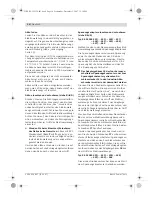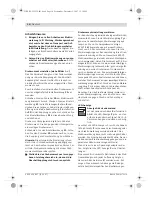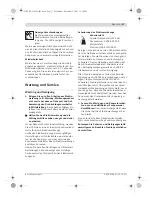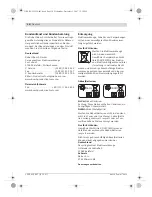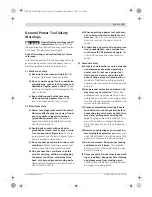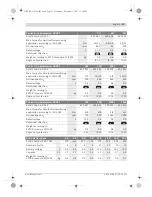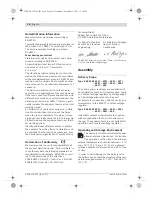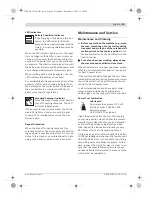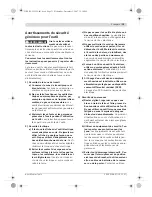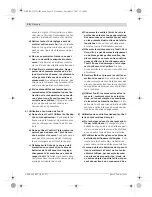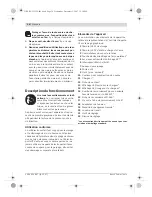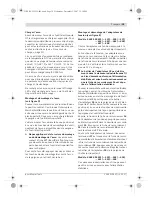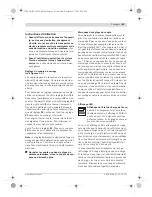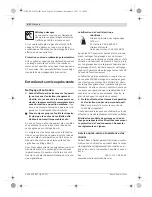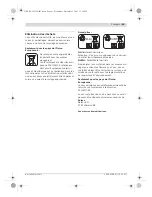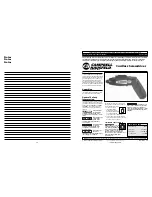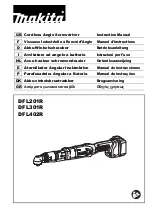
28
| English
3 609 929 B57 | (5.12.07)
Bosch Power Tools
Reversing the Rotational Direction
(see figure G)
Right rotation:
For driving in screws, push the
rotational direction switch
3
left to the stop.
Left Rotation:
For loosening or unscrewing
screws, push the rotational direction switch
3
right to the stop.
f
Actuate the rotational direction switch 3
only when the machine is at a standstill.
Switching on the LED Work Area Illumination
(see figure H)
The work area illumination
20
makes possible
the lighting of the screwing position for unfavo-
rable light conditions. The work area illumina-
tion
20
is switched on by lightly pressing the
on/off switch
6
. When the on/off switch is firmly
pressed, the power tool is switched on and the
work area illumination continues to light.
f
Do not look directly into the work area illu-
mination – your sight can be temporarily de-
graded!
Switching On and Off
The screwdriver have a
shut-off
clutch
that depends on the torque
and can be set in the given range. It
responds when the torque that is
set is reached.
Note:
When operating the screwdriver with a
voltage adapter, the constant voltage regulator
must be put into operation first.
To
start
the machine press the on/off switch
6
to the stop. The machine
switches off automat-
ically
as soon as the preset torque is reached.
f
When the on/off switch 6 is released pre-
maturely, the preset torque is not reached.
Working Advice
f
Before any work on the machine (e.g., main-
tenance, tool change, etc.) as well as during
transport and storage, set the rotational di-
rection switch to the centre position.
Unin-
tentional actuation of the On/Off switch can
lead to injuries.
f
Apply the power tool to the screw/nut only
when it is switched off.
Rotating tool inserts
can slip off.
Setting the Torque (see figures I–J)
The tightening torque is dependent on the
spring pretension of the shut-off clutch. The
shut-off clutch responds in right as well as left
rotation when the torque setting is reached.
For setting the individual tightening torques,
use only the adjustment tool
21
provided.
Push the slide
10
on the power tool completely
back. Insert the adjustment tool
21
into the tool
holder
8
and turn it slowly. When a small inden-
tation (adjusting dial
22
) is visible in the clutch
insert the adjustment tool
21
into the indenta-
tion and turn it.
Turning in the clockwise direction results in a
higher torque, in the counterclockwise direc-
tion, a lower torque.
Remove the adjustment tool
21
. Shut the slide
10
again to protect the clutch against contami-
nation.
Note:
The required adjustment is dependent on
the type of threaded connection and can be best
determined by practical trials. Check the trial
screwings with a torque wrench.
f
Set the torque only in the specified per-
formance range, otherwise the shut-off
clutch will no longer respond.
Marking the Torque Setting
To identify individually adjusted tightening tor-
ques, the marking ring
7
an be replaced with a
marking ring of another color. For example, if
you are using several EXACT tools set to a
torque of 4.5 Nm, you can use the red rings to
marque their set values. If you are using more
EXACT tools in another part of the assembly
process where the torque is set to 7.5 Nm, you
can use another marking ring (such as black,
blue, green or yellow) to mark the torque range
of these units. The different marking rings are
only intended as a quick reference for produc-
tion personnel to easily indentify which tool is
set for a given torque range. Press off the mark-
ing ring
7
with a thin screwdriver blade, a knife,
or similar.
Always use the power tool with a marking ring to
insure that the housing body is sealed from dust
and dirt.
OBJ_BUCH-529-001.book Page 28 Wednesday, December 5, 2007 12:18 PM

